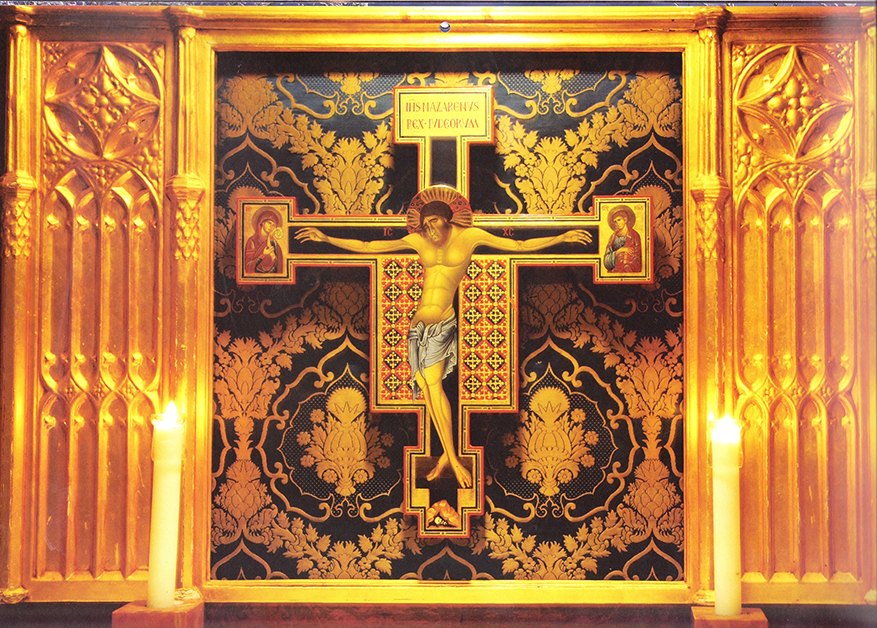I recently learned that the icon I donated to Saint Joseph's Abbey is featured in their 2016 calendar. Please view their website to learn more about this community of Trappist monks living a contemplative life of prayer and work in Spencer, Massachusetts.
Studio Open House: July 26, 2015
I had the pleasure of hosting an informal open house at my studio this past summer. Here are several images of the studio and various works in progress.
October 2014: Exhibition "Sacred Silence" at The Iona College Council on the Arts
The Artist at the opening of the exhibition.
Four local icon painters, Chantal Heinegg, Ofelia Manero, Barbara Vartenigian and Marek Czarnecki wish to share their practice of the Christian sacred art of iconography.
They use the same traditional materials and techniques that were used centuries ago: dry pigments mixed with egg emulsion; consecutive layers of colored paint on the white surface of a wooden board primed with chalk or plaster mixed with rabbit skin glue; and usually complemented with the application of gold leaf.
The colors are blended from dark to light, representing our own spiritual journey, in an attempt to reveal the divine quality of the icon’s subject, whose light originates from within and therefore casts no shadow. Perspective is inverted, so that the converging point is in the heart of the viewer and not on a distant horizon behind the subject. And as concerns the prototype itself, we need only look to the works of iconographers who have gone before us to find the model upon which we can concentrate our efforts to bring forth the life and illumination within them.
An icon, in its most fundamental meaning, is an image of Jesus, Mary, the saints, or some event from Holy Scripture or Christian history. Tracing its origins back to the catacombs of Rome and the funerary portraits of Fayum, iconography has tenaciously survived as a traditional art despite the turbulent iconoclastic movements of the 8th century and, more recently, the Soviet era. It perseveres into the present time, now experiencing an international re-kindling.
Icons are windows, a manifestation of the intersection between human and divine worlds. They are a means of instruction, instruments of prayer and meditation for the iconographer and the viewer alike. Once known as the "bible of the poor" in a time when so few had the privilege of literacy, this form of transmission touches the heart and feeling of the viewer with more immediacy than a written text. It is also why we refer to the “writing” of an icon. The icon expresses a deep and vibrant silence, their timeless quality as relevant today as it was so many centuries ago.
The four painters are "place-keepers". They work in gratitude to the prototypes, spirituality and techniques of historical Eastern Orthodox iconography. Yet as Catholics, they are also answering an ecumenical call expressed at the Second Vatican Council to return to the apostolic simplicity of an early undivided church. Through a respectful adherence to the traditions of iconography, they are re-experiencing the foundations of all Christian art. In this exhibition, we hope to offer the viewer a deeper insight into the process and possibilities of this endeavor and to share our search for this Sacred Silence.
April 2014: Class w/ Alexander Stalnov in Pistoia, Italy (Doubting Thomas)
In April of 2014, I had the pleasure of returning to Pistoia for another class with Alexander Stalnov. This class was devoted to writing "The Incredulity of Thomas" or "Doubting Thomas" based on a prototype by the Russian iconographer Dionisi (c. 1500). The original hangs in the Russian museum in Saint Petersburg.
Working in the studio space.
The studio.
The Maestro
My work in progress...
Still a work in progress...
The completed icon.
October 2012: Class w/ Alexander Stalnov in Pistoia, Italy (Christ Halki)
In October 2012, I participated in a class with Maestro Alexander Stalnov in Pistoia, Italy. Along with 15 other students, I worked on the icon Christ Halki based upon a prototype located in the Cathedral of the Dormition in the Kremlin, Moscow.
Initial drawing on gilded board.
Students gilding the background and kovcheg.
Sample board and typical studio space.
Maestro Alexander Stalnov correcting some of my work.
Here is a photograph of my work toward the end of the nine-day class. You can see two enlargements of the prototype that help guide my work. The sketch at the lower left shows the first two lights on the Sankir.









